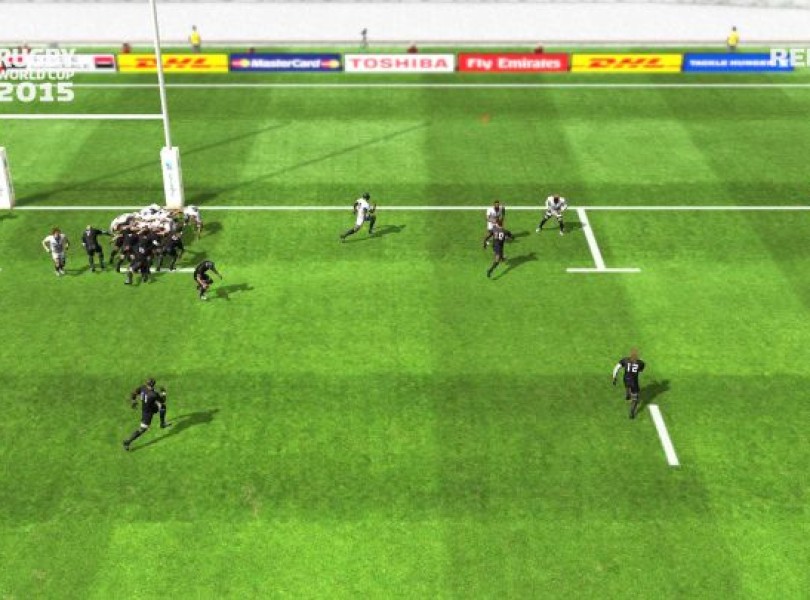→ September 4, 2015
Late last year, I reviewed Rugby 15: an arcade rugby union title from HB Studios with few noteworthy qualities. You can read my review here, but the long and short of that experience is that Rugby 15 was a stinker. Fast-forward nine months, and the same developer is releasing much the same game, with many of the same flaws as Rugby 15, plus some new ones.
I was initially excited to see that HB Studios had attempted to address some of the concerns of Rugby 15. The static tutorial screens are still there, but they showcase additional rugby union nuances atop last year’s offering, as well as some minor but important default control changes. There’s a practice mode now, but the free play option is redundant (you might as well play a friendly match), while the focused training sections are short in quantity and shallow in quality.
The AI-controlled players no longer stand around waiting for you to move before they’ll react, which is an improvement over last year. Unfortunately, more movement from the AI highlights the lack of attention to proper or even practical rugby defensive/offensive formations. You can use the D-pad to cycle between offensive and defensive presets, but this is never explicitly conveyed (I stumbled on it in the controls menu). It also doesn’t alter the atrocious AI.
On one hand, it’s technically easier to score a try, as there’s the option to touch the ball down, on top of a diving mechanic that doesn’t make the ball-handler leap over the dead-ball line (as it once did). On the other hand, most of my tries were scored when I was tackled over the line due to the returning sin of player encounters being determined prior to the animation playing out. In practical terms, this means unresponsive controls when the game has determined that you’re about to be tackled.
Worse than this, though, is the game-breaking bug that happened to me on multiple occasions, wherein being tackled over the try line resulted in completely unresponsive controls and the inability for my opponent to interact with me. On a couple of occasions, I was able to get the player back on his feet by cycling in and out of the menu, but I still couldn’t pass the ball or be tackled. On another occasion, frantically button mashing seemingly repaired the damage and allowed me to complete my try. The other times, I had to simply run over the dead-ball line to reset play.
I could have quit out of these matches in question, but doing so during the titular Rugby World Cup tournament, the main mode and selling point for this game, would result in a forfeit, registered loss (of 0-30, no less) and eliminate me from the qualifying rounds. That’s hardly a practical option considering friendly matches and World Cup mode are the only two modes on offer in the game outside of free-play practice.
On the positive-on-paper side, the all-important ruck isn’t as buggy as it was in Rugby 15. Alas, in execution, it breaks down at the ruck breakdown. Considering the rucks are arguably the most important part of a rugby union game, particularly because of how frequently you’ll encounter them in this game, it’s a terrible oversight. The right-stick mini-game for rucks returns, but setting the difficulty above the lowest level, which is laughably easy, means you have next to no chance of a turnover.
Retaining possession at the ruck breakdown isn’t overly challenging once you wrap your head around the system and learn to anticipate the prompts, but upping the difficulty to normal or hard only seems to reduce the chance of scoring a turnover. It means that rucks are a much faster mechanic than in Rugby 15, but the emphasis on speediness results in a lot of frustration and an overall lack of control.
Rucks are a much faster mechanic than in Rugby 15, but the emphasis on speediness results in a lot of frustration and an overall lack of control.
Even playing with or against someone locally doesn’t fix this problem (there’s no option for online play). The ruck meter fills too quickly to afford either side a practical chance to genuinely steal or regain possession, so it descends into a game of luck and quick reactions. Trying to secure or rake the ball too early means you run the risk of earning a penalty.
Considering the referee is extremely heavy-handed with pulling out yellow cards for ruck infringements, this is once again a slap in the face for the most crucial part of a rugby union game. Hell, you can’t even manually add or remove players from a ruck, and a defensive player advantage on a runaway opponent counts for nothing as both teams politely wait for an equal amount of players to join the ruck before you can interact with it.
The only real improvement in terms of the ruck is the option to perform a short pass, instead of the lobbed-back throws of Rugby 15 that often resulted in lost metres. Rugby World Cup 2015 doesn’t teach you this, but you have to hold the left stick forward while pressing the short-pass button to give your attacking players a running start. That said, even this mechanic would fail to register half the time.
Friendly AI is as bad as the opposition, and I regularly experienced immense frustration as I watched them stuck in the lack of mud (there’s no rain in this game) as a ball-handler ran around, between or even through them. To further complicate matters, the automated player selection button while defending often illogically selects a defender nowhere near the attacker. You can manually select them with the right stick, but even this misses as much as it hits.
The right stick is also used to control manual pass selection and defensive manoeuvres when in possession of the ball, so the game will often miss the intended input of the latter and associate it as being pre-emptive to the former. The result: more blood-curdling frustration.
It’s as if HB Studios knows how bad the friendly AI is because there’s the option to relinquish ball possession to an AI player in order manually move into a running position. This is more confusing than practical, and you often don’t have time to properly position before the AI-controlled teammate is tackled. It becomes an almost essential mechanic, though, when you consider that neither defenders nor attackers put players into the blindside of a ruck, which leaves huge gaps, but little opportunity to capitalise on these moments.
I could go on. I could mention how the way the game handles camera rotations and, subsequently, rucks in end-on perspective destroys momentum and further damages already finicky gameplay systems. I could go on about the delay between a button press and its actual recognition, which destroys the limited immersion during rare moments of forward momentum. I could fixate on how play basically stops to a crawl when there’s a loose ball, how interceptions are almost impossible, or how forward passes seem to work on a cooldown rather than them actually being legitimately called. But there’s really no point.





